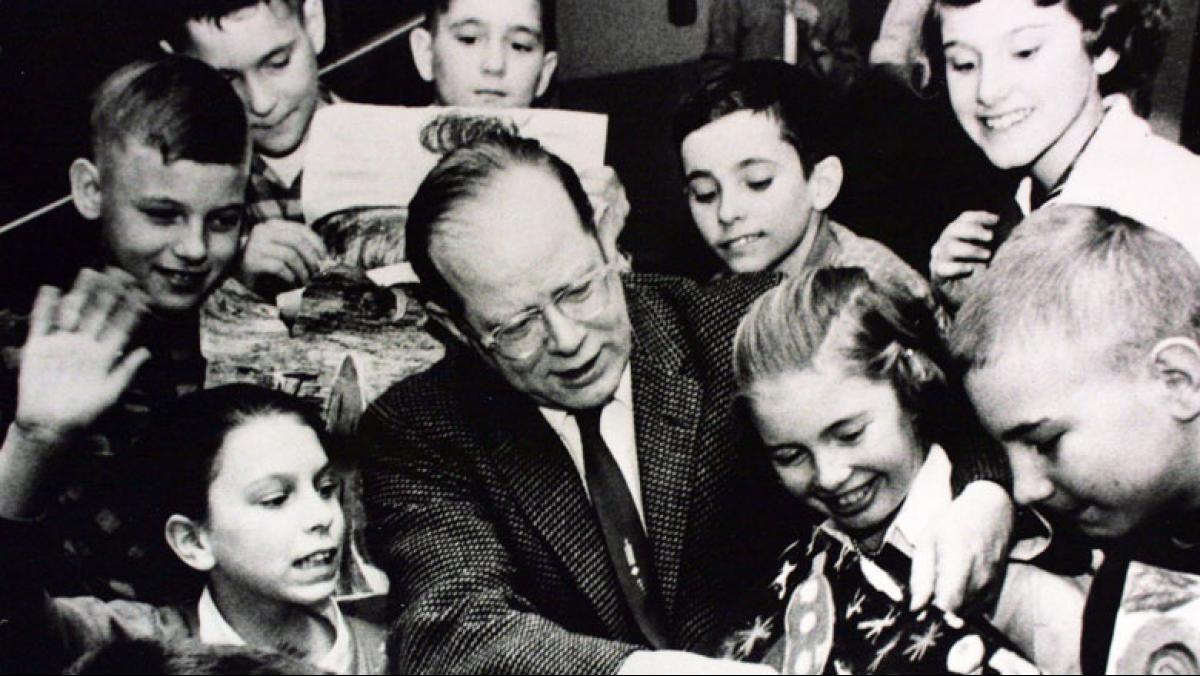Making marks—scratching in the sand, carving into a branch, or marking stone with a charred stick—is a primal human activity. Since prehistory we have used drawing to visualize, explore, refine, and communicate ideas, from the practical to the purely expressive. Drawing helps us understand what we see and imagine and share our vision with others. Whether it’s done with pencil and paper or computer software, drawing remains a fundamental tool for artists, architects, designers, and engineers.
Yet until the 1950s, few American public schools taught drawing or offered any serious art curriculum. Wisconsin was no exception. In the 1930s, the majority of rural schools were comprised of one or two rooms in which several grade levels were taught by a single teacher. There were no specialized elementary art teachers in the state, and few resources to support teachers who wanted to offer art to their students. This deficit inspired a group of progressive-minded educators and radio producers in Wisconsin to develop a radical idea for teaching visual art and a variety of other subjects including music, wildlife conservation, and social studies, over the air. Though many rural homes—and schools—still lacked electricity, battery-powered radios provided a prized new link to the larger world.
“Let’s Draw” was developed by WHA (now Wisconsin Public Radio) in 1936 as part of its School of the Air series of programs designed to provide free courses for the school children and adults of the state. A teacher and recent University of Wisconsin graduate named James Schwalbach had written a thesis on how art might be taught on radio, and was asked to lead the “Let’s Draw” program, which wove together music, stories, dramatic readings, and instruction into lively programs addressed to rural and underserved schools.
Schwalbach felt his own art education had been overly rigid, even stifling, with projects too often limited to copying, tracing, and coloring. He designed the weekly “Let’s Draw” radio lessons to spark enthusiasm and imagination, and to encourage students to treat art as a tool for creative exploration. “Remember, art is fun!,” he’d say, urging students to “Hold the crayon loosely and swing your whole arm with a great big grin on your face.” But Schwalbach also took art instruction seriously, offering techniques for using chalk, crayons, and watercolor along with ideas about composition, texture, volume, and space.
The half-hour broadcasts began with a brief reminder about materials and structure, then quickly moved into a dramatic reading or story, enlivened with music Schwalbach chose himself “to see if [he] could hear the pictures.” To help teachers prepare, Schwalbach sent out an annual manual detailing the themes and materials needed. Although the manuals were illustrated, teachers were urged not to post sample images too prominently to discourage copying.
According to Schwalbach, copying “ruined creative ability” and was antithetical to the central tenets of “Let’s Draw,” which emphasized “personal integration, love of beauty, thrill and pleasure in creative expression.” On air and in his teacher manuals, Schwalbach passionately championed drawing as a vehicle for creative self-expression, unconstrained by adult standards and unfettered by art “rules” (including no rulers!).
The art tools and media Schwalbach chose for “Let’s Draw” also promoted self-expression, and drew from children’s life experiences for subject matter. He often chose topics that might pique the interest and spark the imagination of rural Wisconsin children, such as, “Draw your favorite shack,” “Illustrate a scene from Huck Finn,” or “Draw the funniest thing that happened to you this summer.” Schwalbach considered rulers, pencils, and small-sized paper as hindrances to free expression, and preferred colorful crayons, watercolor, and large paper, which allowed for those relaxed, sweeping arm movements.
Schwalbach’s early curriculum reflects philosophy grounded in Modernist ideals and progressive values. Modernist artists like Kandinsky, Klee, and Matisse drew inspiration from the spontaneity, purity, and simplicity of children’s art. The Modernists, along with progressive art education theorists of the era such as Victor Lowenfeld, believed to a certain degree that direct art instruction and rote learning “corrupts the natural flowering of artistic abilities” and robs children of their “artistic innocence.”
The art teacher’s role, then, was to provide children with materials, propose drawing prompts related to their interests, and offer moral support and encouragement to draw according to one’s own “natural” inclinations.
However, if we trace the arc of activities for “Let’s Draw” during its on-air period from 1936 to 1970, we see how Schwalbach’s curriculum was clearly influenced by broader education reforms, technological advances, and changes in American culture.
While words such as “freedom,” “originality,” and “self-expression” pepper early “Let’s Draw” programs and teaching manuals, they are virtually absent by the mid-1960s, signaling a shift in emphasis on creativity to an expanded curriculum that incorporated concepts and content pertinent to the discipline of art and preparing for a working life. As early as 1959, “Let’s Draw” was teaching students about the elements and principles of design—what’s known as the language of art—as well as media-specific techniques and processes.
By responding to these changes, Schwalbach became a master at teaching students how to develop craft/technical skills and understand ways in which composition and choices regarding elements of art—color, shape, line, texture, space—work together to visually communicate ideas. What makes this so remarkable is that he did it all over the airwaves, with little visual prompting.
Schwalbach kept his drawing prompts open-ended and primarily related to children’s interests, but over time his suggestions for subject matter shifted from almost exclusively narrative illustration of stories, poems, and children’s lived experiences, to include communicating ideas through abstract and non-objective imagery and symbols. While in 1941 a lesson might include a request to draw a “cowboy campfire,” in 1967 Schwalbach asked students to illustrate the twinkling lights of a Christmas tree with the tree as a pattern of abstract shapes and colors rather than a realistic representation. A later lesson required an illustration of the ambiguous concept of “processions.”
When prompting children to draw the building facades from a street in their town, Schwalbach explained the principle of “emphasis” or “center of interest” and then asked students to apply this concept. He expanded the function of drawing in children’s lives to not only serve as a vehicle for self-expression, but also as a powerful visual language in which to communicate ideas.
Even though his expanded curriculum suggested adult standards as a way for children to improve their works of art, Schwalbach maintained that “a good drawing looks like it was fun to produce.” Enjoyment, so central to sustained engagement in the artistic process, remained a high priority for the duration of the program.
Schwalbach’s curriculum for “Let’s Draw” steadily grew more complex and layered over time, keeping in sync with the consolidation of rural school districts and the subsequent expansion and specialization of the teacher pool. By 1960, the still-popular “Let’s Draw” program incorporated printmaking, collage, multimedia, chalk, pen and ink, and markers.
Today the landscape of drawing in contemporary art education is even more multifaceted. Now students have access to digital drawing tablets, design software such as Adobe Photoshop and Illustrator, 3D digital printing, and drawing in virtual reality. Each new media challenges students to develop new techniques, solve new problems, reach new audiences, and create images for new purposes.
While self-expression is still important, contemporary educators introduce students to drawing as a means of brainstorming and planning, as visual explanation (like infographics), as a means of research or investigating ideas and natural phenomena, as a process in which to learn “to think like artists,” and even as a form of social and environmental activism. “Let’s Draw” did occasionally prompt students to use drawing for functional design—fashion, furniture, and toys—but today, children use drawing to tackle an even wider range of challenges related to careers in the visual arts: experience design (video games), environment design (theme parks, homes, urban planning), and object, web, and graphic design.
While he drew philosophical inspiration from the Modernists and often featured the work of local “Badger Artists” such as Warrington Colescott and John Steuart Curry, Schwalbach presented very little about famous artists or major art movements. Art teachers today draw on classic and contemporary artists to help students contextualize their own drawing practice in relationship to a wider community of visual artists. Teachers ask their students to draw using traditional methods such as charcoal, viewfinder, and grid to create representational drawings from observation, and also use experimental methods like “drawing” with natural found objects in site-specific places outdoors.
Similarly, the historical and cultural contexts of art received little consideration in “Let’s Draw.” Today, art teachers who develop culturally relevant curriculum ask students to examine the cultural meanings of a variety of art forms (not just fine art from the Western canon), study artists from diverse backgrounds, and ask children to share their own cultural perspectives in and through art.
The one-size-fits-all curriculum presented in “Let’s Draw” was as much a function of the medium as the way in which the program was used at the time. How drawing is taught in elementary and middle schools today is highly dependent on the developmental stage of the age group. Drawing for a first grader is vastly different than for an eighth grader, and drawing prompts for a six year old, indeed, might reflect the kinds of open-ended, free-from-adult-constraints approach of the early “Let’s Draw” activities. But by eighth grade, students are encouraged to develop technical skill and apply the elements and principles of design in an intentional way to help communicate their ideas, plus understand something of the historical and cultural contexts of their art practices.
Of course, today children, teachers, and just about anyone can directly access drawing instruction through YouTube videos or online art courses. But that feeling of belonging to something bigger, a movement to create art throughout the state, was and always will be unique to “Let’s Draw.”
This was largely due to the time Schwalbach spent promoting the program. He built support by giving awards, organizing exhibits of student work, dropping in (often unannounced!) to observe classrooms during the broadcast, and offering regional workshops. Each week students were asked to submit their classroom’s five best pictures, and WHA volunteer judges rewarded dozens of these with honorable mention postcards each week. The top thirty “Honor Roll” winners were announced on air and became part of a traveling exhibit sent to schools; they were also invited to Madison to help record the last broadcast of the year. As participation grew, this annual Honor Roll gathering was split into several regional events.
These traveling exhibits of student work and Schwalbach’s in-person school visits helped to develop an enthusiastic network of participation in—and support for—the “Let’s Draw” program, which is still remembered fondly decades after leaving the air.





